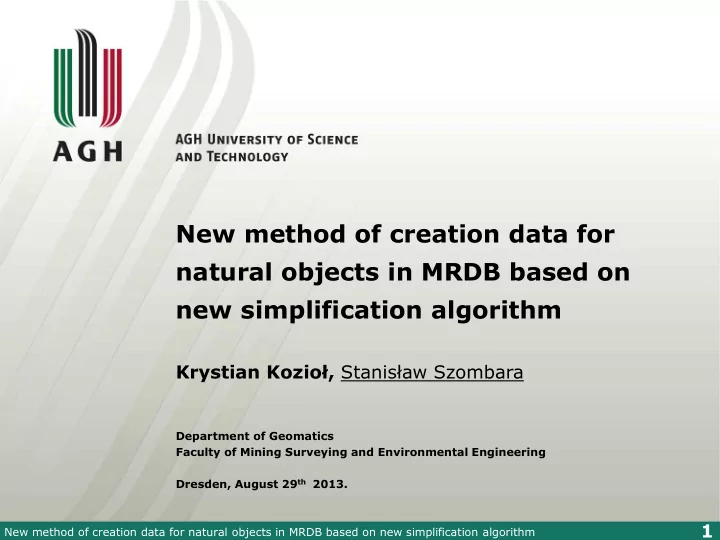

New method of creation data for natural objects in MRDB based on new simplification algorithm Krystian Kozioł, Stanisław Szombara Department of Geomatics Faculty of Mining Surveying and Environmental Engineering Dresden, August 29 th 2013. 1 New method of creation data for natural objects in MRDB based on new simplification algorithm
Introduction One of the main tasks of cartography in the 21st century is visualisation of topographical objects in MRDBs in various scales. According to Sarjakoski (2007), creating MRDB means use of generalisation model considering the following criteria: • most frequently used representation of objects, • requirements of objects updating, • level of automation that can be achieved in the process of creating the representation of objects. BDOT500, BDOT10k and BDOO (1:250k) 2 New method of creation data for natural objects in MRDB based on new simplification algorithm
Simplification operator • Point-reduction algorithms • Scale-driven generalisation algorithms 3 New method of creation data for natural objects in MRDB based on new simplification algorithm
Concept The idea! What if we develop a simplification algorithm that chooses the points on the real object rather then eliminates them? Problems • How to get the real object? • How to place the points (vertices) automaticaly according to the level of detail? 4 New method of creation data for natural objects in MRDB based on new simplification algorithm
Protype The stages of the algorithm are: • Dividing • Interpolation • Determination extreme points • Selection of new intermediate points • Verification 5 New method of creation data for natural objects in MRDB based on new simplification algorithm
Locating the characteristic vertices on a polyline (creating of surjection parts) 6 New method of creation data for natural objects in MRDB based on new simplification algorithm
Creating curve using 3 rd degree Hermite Interpolation The chosen interpolation method should satisfy the following conditions for a curve: • the curve should pass through all the points of a polyline – f(x) = H(x), • the local extreme of a polyline should be preserved – f’(x) = H’(x). We use the Hermite polynomial, compatible with f(x i ) and with f’(x i ) at points x i for i = 0,1,2…,n. The form of the polynomial (Boor 1978) is as follows: ( ) ( ) ( ) ( ) ( ) ∧ = + H x ∑ f x H x ∑ f x H x n n ' n j , = = j j 0 j n j 0 j , 7 New method of creation data for natural objects in MRDB based on new simplification algorithm
Arrangement of points on the original curve according to the standard drawing recognizability In order to distinguish points on the original curve for a map in scale 1:M k we used the recognisability norm based on the elementary triangle (Chrobak 2010): • ε 01 = 0,5[mm]*M k b є [0,5mm – 0,7mm)*M k ], • ε 02 ≥ 0,5[mm]*M k b є [0,4mm – 0,5mm)*M k ] 8 New method of creation data for natural objects in MRDB based on new simplification algorithm
Verification of results Piątkowski (1969) defined the accuracy norm of acquiring curve-like objects and called it the primitive generalization. This generalisation idea consists in use of line segments (chords) in place of corresponding curvilinear sections of a linear object. Piątkowski determined empirically the length of ordinate - e - between the chord and the arc of the curve, called the rise. Length of the rise depends on the scale of map as follows: e ≥ 0,3[mm]*M k, 9 New method of creation data for natural objects in MRDB based on new simplification algorithm
Example results Generalisation from 1:500 to 1:25000 Douglas-Peücker Visvalingam - Whyatt Wang Chrobak The new algorithm 10 New method of creation data for natural objects in MRDB based on new simplification algorithm
Example results Reference scale: 1:500 1:5000 1:10000 10m 1:25000 1:50000 11 New method of creation data for natural objects in MRDB based on new simplification algorithm
Conclusions • The conversion of a polyline into a curve allows arrangement of points on the original curve depending on the target map scale and not source map scale. • The presented method can be implemented to any database of MRDB type under the assumption that the high-detail data will constitute the source data and the results will be used for the purpose of visualization at low level of detail. • The drawing recognizability norm and Piątkowski norm implemented in the simplification process with this particular algorithm gives an unambiguous result and the opportunity for a measurable verification. 12 New method of creation data for natural objects in MRDB based on new simplification algorithm
Thank you for your attention More details: Questions? krystian.koziol @agh.edu.pl szombara@agh.edu.pl 13 New method of creation data for natural objects in MRDB based on new simplification algorithm
Recommend
More recommend